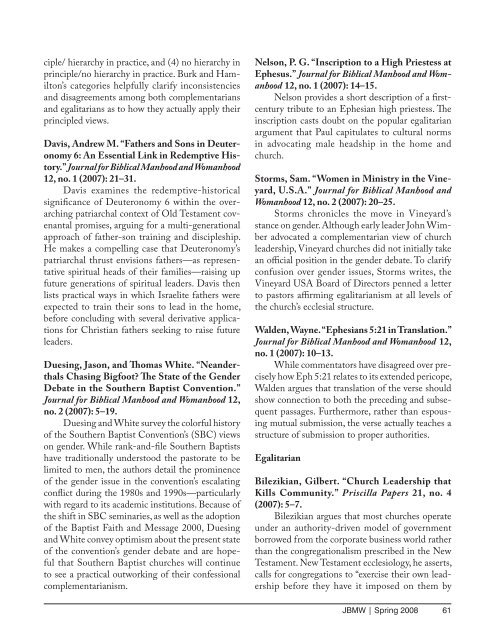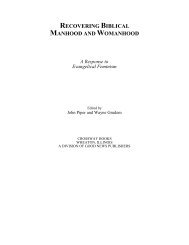Download PDF - The Council on Biblical Manhood and Womanhood
Download PDF - The Council on Biblical Manhood and Womanhood
Download PDF - The Council on Biblical Manhood and Womanhood
You also want an ePaper? Increase the reach of your titles
YUMPU automatically turns print PDFs into web optimized ePapers that Google loves.
ciple/ hierarchy in practice, <strong>and</strong> (4) no hierarchy inprinciple/no hierarchy in practice. Burk <strong>and</strong> Hamilt<strong>on</strong>’scategories helpfully clarify inc<strong>on</strong>sistencies<strong>and</strong> disagreements am<strong>on</strong>g both complementarians<strong>and</strong> egalitarians as to how they actually apply theirprincipled views.Davis, Andrew M. “Fathers <strong>and</strong> S<strong>on</strong>s in Deuter<strong>on</strong>omy6: An Essential Link in Redemptive History.”Journal for <strong>Biblical</strong> <strong>Manhood</strong> <strong>and</strong> <strong>Womanhood</strong>12, no. 1 (2007): 21–31.Davis examines the redemptive-historicalsignificance of Deuter<strong>on</strong>omy 6 within the overarchingpatriarchal c<strong>on</strong>text of Old Testament covenantalpromises, arguing for a multi-generati<strong>on</strong>alapproach of father-s<strong>on</strong> training <strong>and</strong> discipleship.He makes a compelling case that Deuter<strong>on</strong>omy’spatriarchal thrust envisi<strong>on</strong>s fathers—as representativespiritual heads of their families—raising upfuture generati<strong>on</strong>s of spiritual leaders. Davis thenlists practical ways in which Israelite fathers wereexpected to train their s<strong>on</strong>s to lead in the home,before c<strong>on</strong>cluding with several derivative applicati<strong>on</strong>sfor Christian fathers seeking to raise futureleaders.Duesing, Jas<strong>on</strong>, <strong>and</strong> Thomas White. “Ne<strong>and</strong>erthalsChasing Bigfoot? <str<strong>on</strong>g>The</str<strong>on</strong>g> State of the GenderDebate in the Southern Baptist C<strong>on</strong>venti<strong>on</strong>.”Journal for <strong>Biblical</strong> <strong>Manhood</strong> <strong>and</strong> <strong>Womanhood</strong> 12,no. 2 (2007): 5–19.Duesing <strong>and</strong> White survey the colorful historyof the Southern Baptist C<strong>on</strong>venti<strong>on</strong>’s (SBC) views<strong>on</strong> gender. While rank-<strong>and</strong>-file Southern Baptistshave traditi<strong>on</strong>ally understood the pastorate to belimited to men, the authors detail the prominenceof the gender issue in the c<strong>on</strong>venti<strong>on</strong>’s escalatingc<strong>on</strong>flict during the 1980s <strong>and</strong> 1990s—particularlywith regard to its academic instituti<strong>on</strong>s. Because ofthe shift in SBC seminaries, as well as the adopti<strong>on</strong>of the Baptist Faith <strong>and</strong> Message 2000, Duesing<strong>and</strong> White c<strong>on</strong>vey optimism about the present stateof the c<strong>on</strong>venti<strong>on</strong>’s gender debate <strong>and</strong> are hopefulthat Southern Baptist churches will c<strong>on</strong>tinueto see a practical outworking of their c<strong>on</strong>fessi<strong>on</strong>alcomplementarianism.Nels<strong>on</strong>, P. G. “Inscripti<strong>on</strong> to a High Priestess atEphesus.” Journal for <strong>Biblical</strong> <strong>Manhood</strong> <strong>and</strong> <strong>Womanhood</strong>12, no. 1 (2007): 14–15.Nels<strong>on</strong> provides a short descripti<strong>on</strong> of a firstcenturytribute to an Ephesian high priestess. <str<strong>on</strong>g>The</str<strong>on</strong>g>inscripti<strong>on</strong> casts doubt <strong>on</strong> the popular egalitarianargument that Paul capitulates to cultural normsin advocating male headship in the home <strong>and</strong>church.Storms, Sam. “Women in Ministry in the Vineyard,U.S.A.” Journal for <strong>Biblical</strong> <strong>Manhood</strong> <strong>and</strong><strong>Womanhood</strong> 12, no. 2 (2007): 20–25.Storms chr<strong>on</strong>icles the move in Vineyard’sstance <strong>on</strong> gender. Although early leader John Wimberadvocated a complementarian view of churchleadership, Vineyard churches did not initially takean official positi<strong>on</strong> in the gender debate. To clarifyc<strong>on</strong>fusi<strong>on</strong> over gender issues, Storms writes, theVineyard USA Board of Directors penned a letterto pastors affirming egalitarianism at all levels ofthe church’s ecclesial structure.Walden, Wayne. “Ephesians 5:21 in Translati<strong>on</strong>.”Journal for <strong>Biblical</strong> <strong>Manhood</strong> <strong>and</strong> <strong>Womanhood</strong> 12,no. 1 (2007): 10–13.While commentators have disagreed over preciselyhow Eph 5:21 relates to its extended pericope,Walden argues that translati<strong>on</strong> of the verse shouldshow c<strong>on</strong>necti<strong>on</strong> to both the preceding <strong>and</strong> subsequentpassages. Furthermore, rather than espousingmutual submissi<strong>on</strong>, the verse actually teaches astructure of submissi<strong>on</strong> to proper authorities.EgalitarianBilezikian, Gilbert. “Church Leadership thatKills Community.” Priscilla Papers 21, no. 4(2007): 5–7.Bilezikian argues that most churches operateunder an authority-driven model of governmentborrowed from the corporate business world ratherthan the c<strong>on</strong>gregati<strong>on</strong>alism prescribed in the NewTestament. New Testament ecclesiology, he asserts,calls for c<strong>on</strong>gregati<strong>on</strong>s to “exercise their own leadershipbefore they have it imposed <strong>on</strong> them byJBMW | Spring 2008 61




